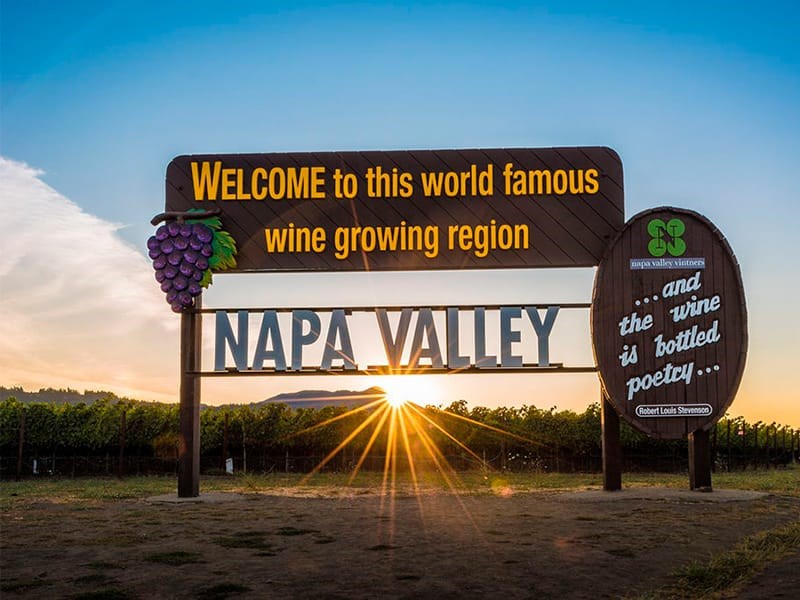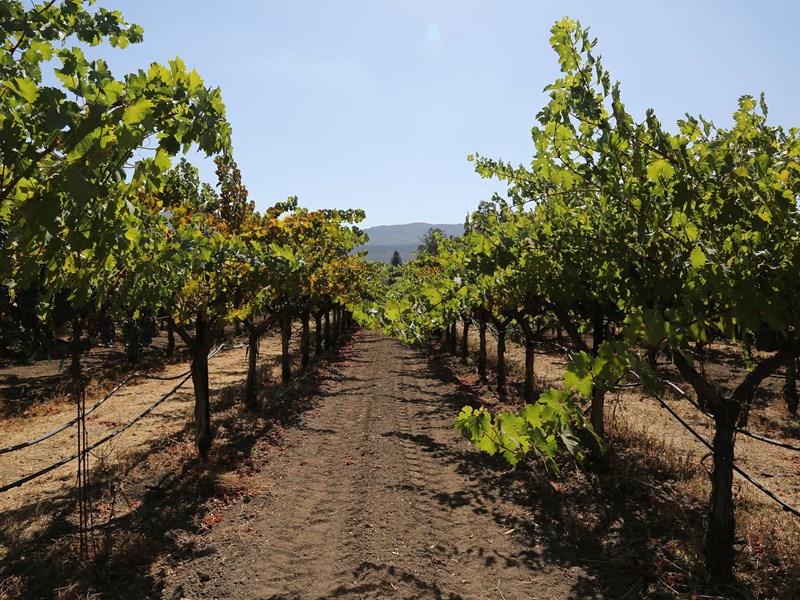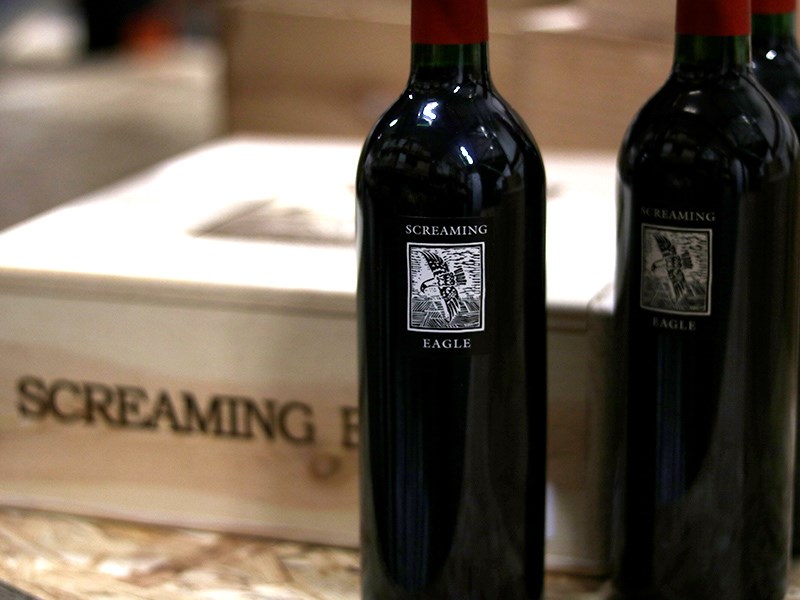Article - RareWine Academy
Napa Valley - The Stronghold Of The Greatest American Wines
Iconic Napa Valley is not only home to some of the world's best wines, but also the birthplace of winemaking in the mighty United States.
If you are not already familiar with the greatest wines of Napa Valley, it is definitely time to widen your horizons. The days when the world's best wines were produced entirely from a Francophile point of view are long gone. Read on to find out why you cannot avoid Napa Valley and more importantly, which wines you simply MUST try.
Why Should You Know About Napa Valley?
It is no secret that huge quantities of wine are produced in California on the west coast of the US, but few places are of as high quality as this small valley in the north of the state. For although the acreage of vineyards in Napa Valley is only 4% of the total acreage of vineyards in California, Napa Valley is responsible for a whopping 25% of the total wine sales in California.
With just over 18,000 hectares, the Napa Valley is planted with less than 15% of what is in Bordeaux and significantly less than the 30,000 hectares in Burgundy. There are 475 wineries in the area, producing a total of around 1000 different wines each year.
Hard work and a handful of stubborn producers have resulted in Napa Valley establishing its name over the 20th century as the place for the best Cabernet Sauvignon wines in the United States, and perhaps the world.
There is definitely value for money in Napa Valley. The wine critics are almost lining up to award the magical 100 points to the best wines from the small valley, and yet they can be purchased at prices significantly lower than comparable quality from Bordeaux. But it has not always been that way on these shores.
 Napa Valley - the American wine dream.
Napa Valley - the American wine dream.
The History Of Napa Valley And The Wine Production
A good hour and a half north of San Francisco is the city of Napa, which also gave its name to Napa County and the beautiful Napa Valley, which in 1980 became America's first official AVA (American Viticultural Areas). The AVA is the American classification of wine regions.
However, the wine production in the area started already in the mid-1800s, but especially the alcohol prohibition in the USA in the years from 1920 to 1933 took the motivation and the financial resources from the producers. Therefore, it is actually only in the mid-1960s that development in the area begins to take off again.
Yet, there was only a handful of producers who dared to focus on quality rather than quantity, but their persistence attracted attention, and more producers came to the area. Beringer, Beaulieu, Inglenook, Christian Brothers, and Charles Krug were among the wineries that persevered in the difficult years after Prohibition.
In the 1970s, the first small producers settled down and established vineyards. Mayacamas was one of the first, paving the way for estates like Diamond Creek and Heitz. These small so-called "garage producers" have really helped to shape the area over the years, creating the hype that still makes the wines highly attractive today.
Then classic producers like Robert Mondavi, Freemark Abbey, and Chateau Montelena followed. All producers could see the quality in the unique soils, warm climate, and exposure in the valley. The quest to establish a wine region that could compete with the best in the world was on!
In 1976 was the famous "Paris tasting". The tasting where a Chardonnay from Chateau Montelena beat the greatest white Burgundy wines, and Stags Leaps Cabernet beat the best from Bordeaux. A tasting organized by an Englishman in France, but which the Americans were quick to exploit for marketing purposes.
Today, Napa Valley is a wonderful mix of large and small producers. Today, the area has established itself as not only the best sub-region in California but as one of the best places in the world to produce Cabernet Sauvignon. The wines from here are on a par with the best wines from Bordeaux and Italy, but usually at a lower price.
Subareas Of Napa Valley
Napa Valley itself is not very large, yet there are 13 different AVA areas in the region. Each AVA is located around a smaller town, and each has its own characteristics. A handful of the main sub-areas are:
Calistoga
Calistoga is the northernmost AVA in Napa Valley. It is the warmest area, but also the area with the greatest difference between day and night temperatures. The soil is filled with volcanic soil, larger rocks up the slopes, and more gravel down at the bottom. Calistoga is particularly known for powerful wines with great depth.
Rutherford
Rutherford is located in the very heart of the valley - right where everything comes together. Located north of Oakville and south of St. Helena. The heat is moderate and balanced by cool morning fog, and the grapes here also benefit from the big difference in day and night temperatures. The wines are characterized by plenty of complexity and diversity.
Oak Knoll District
The Oak Knoll District is located in the southernmost part of Napa Valley and is greatly influenced by the cool breezes of San Pablo Bay. Soils are with much alluvial soil and some volcanic soil. The lower temperature of the area allows for both Riesling and Sauvignon Blanc to work at this end of the valley. Of course, both Merlot and Cabernet Sauvignon can be found, which appear fresher than the wines from the northern part of the valley.
Carneros
Carneros is a slightly different AVA, as it covers the bottom of Napa Valley, as well as the bottom of Sonoma Valley. It stretches along the northern line of San Pablo Bay, which also affects the climate here. Most of the season is cool but at the same time stable - both early and late in the season. This makes the perfect conditions for Pinot Noir; the best of the region can be found here. With climate change in mind, Syrah is also starting to show excellent results here.
Howell Mountain
In recent years, more attention has been paid to the mountain areas. Howell Mountain is on the east side of the valley and starts at just over 400 meters. The vineyards are all above the morning fog and have almost no influence from the sea. The volcanic soils help preserve the freshness of the wines. Especially the wines based on Cabernet Sauvignon and Merlot are with great finesse and length.
Mt. Veeder
Veeder Mountain is located on the west side of the valley, on the border with Sonoma in the Mayacamas mountain range. The vineyards are at altitudes of up to 800 meters with poor soils but good drainage. The altitude alone helps create cool temperatures, and most wines appear with nice elegance. Cabernet Sauvignon and Merlot are the dominant grape varieties in Mt. Veeder
 Long stretches of vineyards and hills in the horizon.
Long stretches of vineyards and hills in the horizon.
Climate And Soil In Napa Valley
Napa Valley is extremely complex in its soil composition. Like the rest of California, the valley is on the edge of two tectonic plates that collide, which also makes the soil relatively young. The complexity has come from abrasion over the past many collisions and retractions of these plates.
This has left large volcanic deposits through the valley, known as 'Napa benches,' or almost like plumes spread through the valley. Here, the soil is quite optimal for grape growing. The combination of minerals and ancient volcanic soils is quite unique.
In addition, the valley itself is located between two mountain ranges, allowing the area to be divided into two main zones. The valley floor is generally warm, with the influence of morning fog coming in from San Pablo Bay. Most of the classic wine producers are located here. The two mountain ranges offer altitude, and thus coolness. This results in wines with a different freshness.
Napa Valley has a warm Mediterranean climate, which means very hot summers and cooler winters. Most of the precipitation falls outside the growing season for the vines, so the right soil composition is essential. The soil must both hold the water that has fallen in the winter but also be able to dispose of excess water that falls.
Other important climatic influences come from the cold winds from the sea. The cold wind enters both up north in the valley and down south through San Pablo Bay. The cool air creates haze, which helps to cool the grapes in the early morning hours. The difference created between daytime and nighttime temperatures helps preserve better acidity in the grapes. Finally, it helps to create a beautiful balance in the wines.
In recent years, climate change has been a major issue in Napa Valley, and the rest of California. Large wildfires have spread across much of the area, critically affecting harvests.
Grape Varieties In Napa Valley
The different soil types in Napa Valley, combined with the slightly different exposures, allow several grape varieties to be grown in Napa Valley, and with high quality as a result.
Cabernet Sauvignon is the king of the valley, not only in terms of quantity but definitely in terms of fame. Well over 50% of all grapes planted in Napa Valley are Cabernet Sauvignon. The grape does very well both on the valley floor and in some of the higher elevation vineyards. In the valley, the wines have more intensity and compact structure; on the hillsides, more acidity is achieved, resulting in wines with a different freshness and lighter style.
Chardonnay is second on the list with just under 15% of the grapes in the valley. In places where Chardonnay can get a bit of coolness, it produces wines with more richness. In the warmer areas, it is also grown, producing great powerful wines with lots of complexity. Often, these wines are barrel-aged to create the right balance and intensity in the wines.
Merlot is the next blue grape on the list with less than 8% of the grapes in Napa Valley. A grape that in some cases stands alone and shows some of the best single grape Merlot outside of Pomerol. A large amount is also used to blend with Cabernet Sauvignon, just as it is done at the best châteaux in Bordeaux.
In addition, there are Pinot Noir, Sauvignon Blanc, and Zinfandel - all with lower percentages. Especially in the cooler parts, in southern Napa, you can work with some of the grapes that benefit from cooler climates.
Noteworthy Producers In Napa Valley
There are now many noteworthy producers in Napa Valley, although the area is relatively small. The base level is sky high. Here will have listed seven producers you simply MUST know.
Screaming Eagle is a very small winery, but one of the most sought after and hyped. Screaming Eagle accounts for a small production of some of Napa Valley's finest wines and highest prices. Screaming Eagle has a relatively small vineyard just outside the winery of fewer than 20 hectares, which is located in Oakville and is the benchmark wine from here. The red wine is made from a classic Bordeaux blend of Cabernet Sauvignon, Merlot, and Cabernet Franc. A small amount of white wine is made from Sauvignon Blanc, which is even more cult than the red.
Robert Mondavi is the man who has really helped to promote Napa Valley through wines at the highest level. When he left the Charles M. Krug family winery in 1966, many thought it was to relax, but he actually ended up establishing his own winery, and from there, the rest is history, as they say. From the start, the focus was on making Cabernet Sauvignon wines on par with the best in the world - and Robert Mondavi has certainly succeeded. In 2004, Robert Mondavi Winery was sold to Constellation Brands and Robert himself was able to retire as one of the greatest icons in Napa Valley history.
Opus One - If you say Robert Mondavi, you cannot avoid saying Opus One, thinking of the first transatlantic collaboration. Robert Mondavi met the legendary Baron Philippe de Rothschild on a holiday in Hawaii. There, they talked their way into the idea of making a wine together in Napa Valley, based on the expertise the Rothschild family could bring to the table. The Rothschild family has been producing top wine at Château Mouton-Rothschild in Bordeaux for a hundred years. The love child between the two legendary producers became Opus One. From its first vintage in 1979, Opus One was a success that has only improved over the years. Today, Opus One is clearly one of the leading wineries in Napa Valley.
Harlan Estate was established in 1984 by millionaire Bill Harlan in the western part of Oakville. Harlan purchased just over 100 hectares and planted 16 hectares with vines. Over the years, Harlan has established itself as an extremely strong brand with high-value growth. Most major writers have helped place the wines of Harlan at the top of the hierarchy, which also brings demand from around the world.
100 Acre is a winery named after the fictional forest in Winnie the Pooh. It hardly gets more American, yet Hundred Acre Winery was founded by a Canadian, Jayson Woodbridge. Today, the name is internationally recognized and a strong brand. Hundred Acre is, in fact, a winery that produces some of the purest Cabernet Sauvignon wines, based on fruit from single vineyards in the mountainous regions. The uncompromising approach of the charismatic owner results in wines of great intensity and broad shoulders. These are wines that year after year is awarded 100 points by The Wine Advocate and other major media.
Inglenook And Francis Ford Coppola
Today, there are plenty of celebrities in Napa Valley, but one man arrived as a winemaker before he really became famous. Francis Ford Coppola was already acquiring vineyards in the 1970s after he made his earliest money on the first Godfather movie. The story of building Inglenook from greatness to its downfall and back again is enough material for a movie. Imagine if it was Francis Ford Coppola himself directing?
Francis Ford Coppola was raised by Italian ancestors, so making wine for his own consumption has always been natural for him. Once he had money of his own, he was able to start his dream of reuniting one of history's great adventures in Napa Valley, Inglenook. First, he acquired a portion of the vineyards that were for sale in the 1970s. Later, the buildings and names were misappropriated by big investors, and a bottle of Inglenook was worth $2 at the supermarket, known as a two-buck chuck rather than a wine from an acclaimed Napa Valley producer.
In the late 1990s, Francis acquired the last vineyards, and then the buildings. Today, Inglenook looks better than ever. The winemaker is Philippe Bascaules, who also makes the wine at Château Margaux in Bordeaux. Recent vintages attest that historic Inglenook is now back among the leading producers in Napa Valley.
Chateau Montelena has a history that goes back to 1882 but only came to the limelight, when their Chardonnay won the famous "Paris tasting" in 1976 over the best wines from Burgundy. Today, Chateau Montelena is considered an extremely stable producer at the better end of the spectrum from Napa Valley for both red and white wines - and the history is very much still with Chateau Montelena.
Beringer Vineyards is the oldest continuously operated winery in Napa Valley. Today, Beringer produces wines from many regions in California, but the core is in Napa Valley. Beringer is a winery that has definitely helped shape the region. In 2015, the latest addition to the family, Jacob Beringer, took over. Today, Beringer is best known for their large productions, but their best wines are still really good exponents of Napa Valley.
 Screaming Eagle is one of the brightest stars in Napa Valley
Screaming Eagle is one of the brightest stars in Napa Valley
The Future Of Napa Valley
America is the land of opportunity, and the opportunities are many for Napa Valley. The biggest challenges are undoubtedly the climate, which in recent years has caused drought in the vineyards and unfortunately also caused several forest fires in the area.
Quality, despite climatic challenges, is higher than ever across the valley. The best wineries are now among the absolute elite worldwide, and the new ones that are emerging have really interesting things to offer.
Cabernet Sauvignon has been the trend-setter in Napa Valley for many decades, and it will likely continue to be so for many years to come. Napa Valley is definitely one of the best places in the world to work with Cabernet Sauvignon and can no longer be called an imitation of anything but has certainly established its own style.
Also, for investment, interesting things are starting to happen to the best American wines, where the quality is on par with and sometimes surpasses the best French wines. Wine critics have certainly taken notice of the best American wines, where steady price increases have also taken place as demand increases. As a result, there are now a good handful of American wines from Napa Valley that can be described as investable.
If you are interested in learning more about which Napa Valley wines we currently offer for investment, please do not hesitate to fill out the form at the bottom of this page and we will get back to you as soon as possible.
